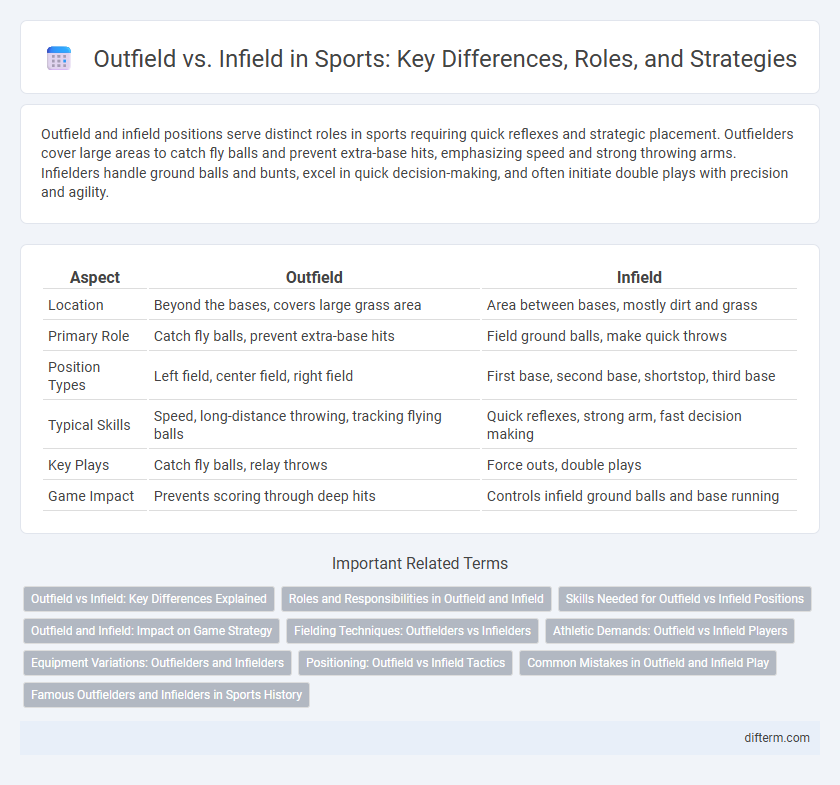Outfield and infield positions serve distinct roles in sports requiring quick reflexes and strategic placement. Outfielders cover large areas to catch fly balls and prevent extra-base hits, emphasizing speed and strong throwing arms. Infielders handle ground balls and bunts, excel in quick decision-making, and often initiate double plays with precision and agility.
Table of Comparison
| Aspect | Outfield | Infield |
|---|---|---|
| Location | Beyond the bases, covers large grass area | Area between bases, mostly dirt and grass |
| Primary Role | Catch fly balls, prevent extra-base hits | Field ground balls, make quick throws |
| Position Types | Left field, center field, right field | First base, second base, shortstop, third base |
| Typical Skills | Speed, long-distance throwing, tracking flying balls | Quick reflexes, strong arm, fast decision making |
| Key Plays | Catch fly balls, relay throws | Force outs, double plays |
| Game Impact | Prevents scoring through deep hits | Controls infield ground balls and base running |
Outfield vs Infield: Key Differences Explained
Outfielders cover the expansive grassy area beyond the infield, requiring speed and strong throwing arms to catch fly balls and prevent extra-base hits. Infielders operate within the diamond, focusing on quick reflexes and precise throws to field ground balls and make plays at bases. Understanding these roles highlights their strategic importance in field positioning, reaction time, and defensive responsibilities in sports like baseball and softball.
Roles and Responsibilities in Outfield and Infield
Outfielders primarily focus on catching fly balls, preventing extra-base hits, and backing up infielders during plays, requiring speed and strong throwing arms to cover large areas. Infielders manage ground balls, double plays, and baserunner control, emphasizing quick reflexes, precise throws, and strategic positioning near bases. Both roles demand coordination and communication to execute defensive plays effectively in baseball or softball.
Skills Needed for Outfield vs Infield Positions
Outfield positions require exceptional speed, long-distance throwing accuracy, and the ability to track fly balls across expansive field areas. Infield players need quick reflexes, precise ground ball handling, and sharp decision-making skills for rapid throws to bases. Both positions demand strong situational awareness, but outfielders prioritize range and arm strength, while infielders emphasize agility and quick release.
Outfield and Infield: Impact on Game Strategy
Outfield and infield positions significantly influence game strategy by defining defensive coverage and player roles. Outfielders focus on catching fly balls and preventing extra-base hits, requiring speed and strong arms, while infielders specialize in quick reactions and ground ball fielding to execute double plays and control the bases. Strategic positioning between outfield and infield affects pitch selection, base running decisions, and overall team defense efficiency.
Fielding Techniques: Outfielders vs Infielders
Outfielders specialize in tracking fly balls and covering large ground with quick, long throws to bases, emphasizing speed and strong arm accuracy. Infielders focus on rapid reaction times, precise glove work, and quick, short throws to execute plays like double plays and force outs efficiently. Mastery of position-specific fielding techniques enhances defensive strength and reduces opponents' scoring opportunities.
Athletic Demands: Outfield vs Infield Players
Outfield players require exceptional speed and endurance to cover large areas of the field, making quick sprints and long runs essential for tracking fly balls. Infielders need explosive reflexes and agility to respond rapidly to ground balls and execute precise throws within tighter spaces. Both positions demand specialized training, with outfielders emphasizing cardiovascular fitness and infielders focusing on reaction time and hand-eye coordination.
Equipment Variations: Outfielders and Infielders
Outfielders use larger gloves, typically 12.5 to 13 inches, to catch fly balls and cover more ground, while infielders opt for smaller gloves, around 11 to 11.75 inches, to enable quicker transfers and precise throws. Infield gloves often have a shallow pocket to facilitate fast ball retrievals, contrasting with the deeper pockets of outfield gloves designed to secure high-flying catches. Cleats and protective gear also vary, with infielders favoring lighter cleats for agility and outfielders using more robust ones to handle sprinting across grass and dirt.
Positioning: Outfield vs Infield Tactics
Outfield positioning prioritizes covering large areas and anticipating deep hits, with players often positioning themselves based on batter tendencies and game situations to maximize range and catch potential. Infield tactics emphasize quick reflexes and strategic placement near bases to optimize force outs, double plays, and bunt defenses while maintaining close communication with the pitcher. Effective coordination between outfield and infield players ensures seamless coverage of the field, reducing gaps and improving overall defensive efficiency.
Common Mistakes in Outfield and Infield Play
Misjudging fly balls and failing to communicate effectively are common mistakes in outfield play, often leading to dropped catches or collisions. Infield errors frequently stem from poor footwork and slow reaction times, which result in missed ground balls and inaccurate throws. Both positions require precise coordination and situational awareness to minimize costly defensive lapses during baseball or softball games.
Famous Outfielders and Infielders in Sports History
Famous outfielders like Willie Mays and Roberto Clemente are celebrated for their exceptional speed, defensive skills, and powerful hitting that transformed baseball's outfield play. Infield legends such as Cal Ripken Jr. and Ozzie Smith are renowned for their precision, agility, and leadership, setting records and elevating the defensive standards in baseball's infield positions. These athletes' impact on the sport is reflected in their multiple Hall of Fame inductions and enduring legacies within Major League Baseball.
outfield vs infield Infographic

 difterm.com
difterm.com